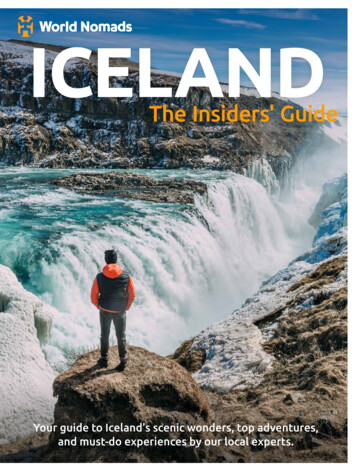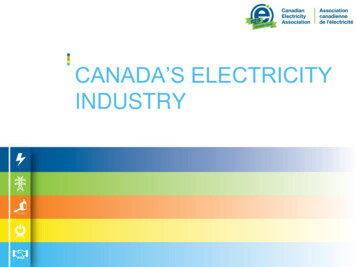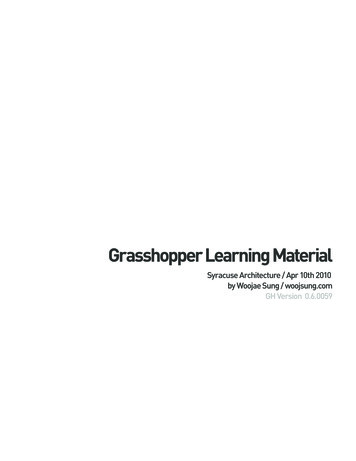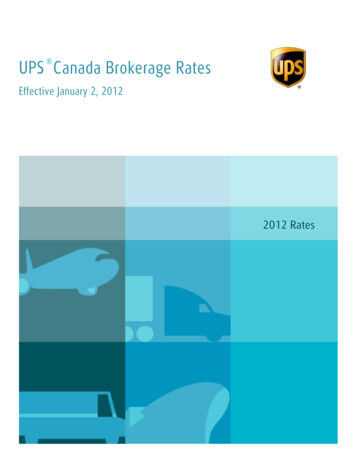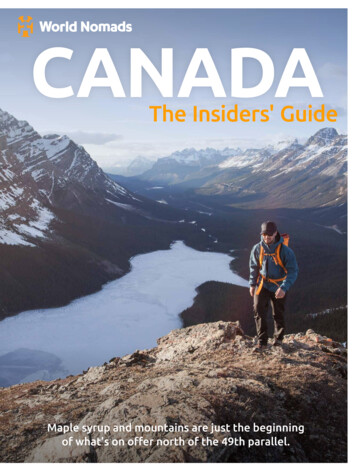
Transcription
CANADAThe Insiders' GuideMaple syrup and mountains are just the beginningof what’s on offer north of the 49th parallel.
ContentsOverviewOntarioTorontoOttawaAdventure in Ontario23242628British ColumbiaVancouver3031Prairies & NorthAlbertaManitobaSaskatchewanThe YukonNorthwest Territories383942434547Atlantic ProvincesNova ScotiaPrince Edward IslandNewfoundlandNew Brunswick4950525355Essential Insurance TipsOur ContributorsSee Our Other esQuebecQuebec CityMontrealAdventure in QuebecVancouver Island and VictoriaWhistlerHaida GwaiiAdventure in British ColumbiaPrairies& North0303060709111315BritishColumbiaOverviewTop 10 Experiences in CanadaClimate and WeatherAccommodation and TransportCultural HighlightsFood in CanadaTravel SafetyVisasQuebecContents2
LUMBIAHaidaGwaiiWhistlerVancouverNEWFOUNDLAND& onCalgaryLabrador CitySaskatoonQuebec CityOttowaMontrealNOVA SCOTIAHalifaxTorontoWith long winter nights, dry crisp air, andclose proximity to the magnetic northneed a big aurora storm for the greens,Canada is by picking a route, hiring apinks, and red hues to be visible – justcar, and driving around. While the twocloudless skies!The northern lights are visiblefrom Yellowknife, but, for the bestOntarioHands–down, the best way to explorewitness the northern lights. You don’tBritishColumbiaone of the best places in the world toCanada’sNorthwestTerritoriesis one ofthe bestplaces inthe world towitness thenorthernlights.QuebecChase the aurora inYellowknifeRoad-trip your wayaround CanadaThe Cabot Trail on the east coast and theNEWBRUNSWICKWinnipegpole, Canada’s Northwest Territories ismost popular road-trip itineraries ECOverviewOur Pick of theTop 10 Experiencesin CanadaNORTHWESTTERRITORIESContentsFjords and mountains,lakes and glaciers,icy roads andnorthern lights,catching a waveon the coast – ifthere’s an adventure you can’tfind in Canada, you probablyhaven’t searched far enough.What’s it gonna’ be then, eh?A kayak, canoe, trusty pair ofhiking boots, or a rentalvan – the choice is yours.Icefields Parkway in Alberta, there arefar more provinces to explore.through Canada’s Maritime provinces –starting in Saint John, New BrunswickPrairies& NorthWhy not take a two-week driveYukonand wrap up the trip in Halifax, Novatake the two-to-three day Sea-to-SkyHighway, starting in Vancouver, andhead north along Highway 99 to end theAtlanticProvincesScotia. Or, if you’re shorter on time,trip in Whistler.3
experience, it’s a good idea to ventureaway from the city lights further north– which will give you the chance to driveon top of a frozen lake.Explore the Canadian RockiesIf glaciers and mountains, milky blue lakesContentsand evergreen forests leading the wayto alpine meadows sound like a dreamto you, choose your method of transport(by bike or on foot) and go backcountrycamping in the Canadian Rockies.Spirit Island, Canadian Rockieslong as you go beyond the main trails.“Revi”, as the locals call it, receives anDying to see Lake Louise? Don’t stop atincredible 600 inches (1.2m) of powder,the lake’s head by the chateau – followthe well-marked trail to Lake Agnes Teafor views across the valley.Or, for a more chilled experience inKootenay National park, take the shortwalk to Marble Canyon then head on topools that run from bright orange tolurid green.Ski the slopes of Revelstokedo backcountry touring and cat skiing.Not quite up to scratch on theboarding skills? Most (if not all) of themountain resorts in Canada offer snowshoeing, cross country skiing, snowmobiling, ice skating, tubing, sleigh rides,and some even have dog sledding andwinter biking available.Brave the cold in the YukonVisit the wild territory of northwestCanada, known as the Yukon, to see thecharming gold rush town of Whitehorse,marvel at dinosaur skeletons in theBritishColumbiaHere in the Selkirk Mountains, you canoff-track skiing and boarding.Ontariothe Point Pots – a series of spring-fedannually – which makes it ideal for someQuebecHouse (4.3mi/7km) in the late afternoonMacBride Museum, or bathe in thesoothing waters at Takhini hot springsbefore a long day on the tundra.If your trip to the Yukon falls betweenlate-August to mid-April, be sure to lookPrairies& NorthIf glaciersandmountains,milky bluelakes andevergreenforestsleadingthe wayto alpinemeadowssound likea dreamto you, gobackcountrycampingin theCanadianRockies.OverviewBeating the crowds is still easy, soup to the skies for the aurora borealis.RevelstokeOff Canada’s northwest coast, theAtlanticProvincesLearn about culture on theHaida Gwaii archipelagoHaida people have lived 12,500 years4
Valley-Goose Bay, but the landscape istruly out of this world. Here, you’ll alsocatch the spectacular northern lights.The Inuit have called this place homefor thousands of years and also run thebase camp, offering the opportunity tolearn about their way of life, first-hand.From remote national parks and quaintfishing villages to whale watching andwild rafting opportunities, once youarchipelago. Embrace the Haida beliefadd in the excellent seafood and superthat all living things are connectednice people, Nova Scotia becomes anby walking among monumental orabsolute must for travelers.mortuary poles (never called totems),It takes two tiny ferries to get toBriar Island, but the long journey is wellceremonial feast).worth it. Start here for whale watchingtours that’ll take you to see humpbacks,finbacks, and right whales. Stop on thespecies. Be on the look-out for cyclingway at Lavena’s Catch Café in Freeportand hiking trails, see eagles feasting onfor an amazing scallop sandwich.salmon left behind by fishermen, andtake a boat to Gandll K’in Gwaay.yaayOntariotraditions plus 6,800 flora and faunaQuebecor attending a community potlatch (aThese misty islands shelter HaidaOverviewon the 200 islands of the Haida GwaiiContentsIce fishingStuff yourself silly withseafood in Nova ScotiaOnce youadd in theexcellentseafoodand supernice people,Nova Scotiabecomesan absolutemust fortravelers.(Hotsprings Island) for a dip in a hotsprings pool revered for healing.BritishColumbiaIcebergs and out-of-this-worldlandscapes in NewfoundlandNewfoundland is the only provincewhere icebergs make a yearlyPrairies& Northappearance. During the summer andwinter months, icebergs can regularlybe seen from the coast along “IcebergAlley”, a stretch of area from the coast ofIf you’re really up for the adventure,make the trip from Labrador city up toTorngat Mountains National Park. It’sonly accessible via plane from HappyNewfoundlandAtlanticProvincesLabrador down to the northeast coast.5
See the tidal changes atHopewell Rocks, NewBrunswickThe uninitiated refer to New Brunswickas a ‘drive-by’ province, but those inthe know come for tasty food, diversecultures, and all the adventure you canwarm salt-water beaches.As you whizz around the Bay ofFundy, make sure you stop twice atHopewell Rocks – once at low tide tomud flats, and again around six hourslater to see the world’s highest tides.On the wild west coast of VancouverIsland, Tofino is where you’ll find artsyvibes, ancient rainforests, and some ofCanada’s best waves to surf. Head tounbelievably cute sea otters.If the conditions are right, hire asurfboard and a thick wetsuit to catch awave or two on Long Beach – Canada’sSUMMERFrom June to August, Canadian summers mean outdoor fun.With varying levels of humidity, temperatures range between59–95 F (15–35 C). The far north is a bit cooler, but also boastsexceptionally long days at the height of summer.Where to go: Everywhere! Rent a car and camp your way acrossthe country. For food and wine lovers, regions like the Okanagan,Niagara, and Prince Edward County are at their best in the summer.AtlanticProvincesCan’t pick between summer and winter travel? Unless you havespecific winter sports or activities in mind, Canada’s summer – with itslong daylight hours and endless adventures – is an ideal time to visit.Prairies& NorthFALLBeloved across the country, fall offers refreshingly cool weather,around 41–59 F (5–15 C), and spectacular autumn foliagethroughout September and October.Where to go: For the best fall colors, head to Cape Breton orOntario’s Algonquin Park.BritishColumbiamost famous surf spot.SPRINGA time of tulips and cherry blossoms, traveling in the spring can bea great way to avoid the crowds. Keep in mind that light snow orrain can continue into May or June, so while temperatures typicallysit around 50–68 F (10–20 C), you should pack accordingly.Where to go: For classic spring scenes between March and May,head to Canada’s most temperate climates in Vancouver andVancouver Island.OntarioClayoquot Sound to see gray whales andWINTERWhile conditions vary significantly, snow typically beginsin October/November and stays around until March/April.Temperatures can range from 50 F (10 C) to -31 F (-35 C), anddip even lower in the north. The west coast predominantlyexperiences rain throughout the winter, with only someperiods of snow.Where to go: Whitehorse or Yellowknife for northern lights,Churchill for polar bear viewing, British Columbia or Banff forskiing or Quebec for winter festival fun.QuebecCatch a wave onVancouver IslandEn-route to JasperOverviewchase sandpipers through the squishyCovering millionsof square miles,Canada is comprisedof everything fromshrub-strewn desertsto the vast Arctictundra. Weather-wise,here’s what to expectand where to go.Contentspack into mountains, marshes, andClimate andWeather6
Accommodationand TransportContentsBetween wilderness escapes and wildlifeencounters (most of which are not planned),travel around Canada can be time-consumingand expensive. Whether you opt for a rentalcar and hired tent or cheap hostels andAirbnb, here’s what to expect.Getting around Canadato get from province to province inCanada. It’s still a heckuva long wayfrom Halifax to Vancouver, 2,734mi(4,400km), and a long flight. Fares 500).The most relaxing and scenicoption is to take the train acrossCanada. Via Rail offers train service(from Montreal to Halifax) are themost luxurious options.Buses are also widely available, andpublic transportation in the majorcities – especially Toronto – is verygood. Taxis are expensive, and canoften be avoided.The UP Express train fromToronto’s Pearson airport into thedowntown core is a great option, andVancouver offers the Skytrain intoOntariofrom coast to coast. If you wantVancouver to Toronto) and The OceanQuebecgenerally start at about US 409 (CWithhundreds ofprovincialand nationalparks, youcan easilycamp yourway aroundCanada.to splurge, The Canadian (fromOverviewObviously, flying is the fastest waydowntown (both cost about US 7.38or C 9).If you want an eco-friendly holiday,BritishColumbiaEco-friendly optionsyou probably want to visit Canadain summer when there’re far morespectacular fall colors, which is duringlate September.Prairies& Northoptions. The early fall season bringsWith hundreds of provincial andyou can easily camp your wayaround Canada. Camping is relativelyinexpensive at about US 24.60/nightAtlanticProvincesnational parks across the country,(C 30) and of course a low-impact7
activity. You could rent a car, an RV/campervan, or even cycle – thoughthe distances are vast. Within cities,there are bike sharing systems.Renting a car or RV/campervan willbe expensive, at about US 819/week(C 1,000) including gas and insuranceContents(note: it’s a good idea to carry aninternational driver’s license). But it’sa great way to get from campgroundto campground.Otherwise, taking the bus isOverviewprobably the best eco-friendlytransportation option to get acrossCanada. You could also join an ecofriendly tour – there are lots tochoose from including wildlife tours,much, much more.AccommodationLike transport, accommodation inaffordable options are hostels and, inthe summer, camping. A quick check onHostelworld.com shows 103 hostels in47 cities in Canada. The average price isBed and breakfasts are a popularchoice in Canada, and can give you amore culturally-authentic experience.To find reputable places, BBCanadaa directory of bed and breakfastsin Canada, as well as regionalassociations. They generally start atcan be less in small towns.Airbnb is as popular in Canada aseverywhere else, so be sure to shoparound online before you book.Mike Carter, Travel Writer.Hear more from his interview, featured in The World Nomads anadaAtlanticProvincesabout US 82/night (C 100), thoughThe accommodation is in bear-proof plastic domes, which are actuallyvery cosy. Although there’s an electric fence around the camp, bearshave been known to break through it – especially if they’re hungry!The Inuit are remarkable people, adept at survival in conditionsthat most of us could not survive for one night. There’s certainlysomething to learn from an experience on Labrador’s far north coast.Prairies& North(https://www.bbcanada.com/) isDuring the day, you can go hiking up nearby mountain ranges withInuit guides (who are always armed because of ever-present polar andblack bears), or take a boat trip around Saglek Bay to see the icebergsand minke whales. In the evening, look up at the stars to see thenorthern lights, listen to Inuit musicians, artists, and throat signers, orwitness drum-dancing performances.BritishColumbiaabout US 32.80/night (C 40).Go beyond the metropolitan cities and head further north toexperience Inuit culture in Torngat Mountains National Park. TheNational Park was set up to allow the next generation of Inuit toreconnect with their ancestral lands and culture after they wereremoved and sent to towns further south in the 1950s. Young Inuitcan meet with elders and learn about the old ways of hunting,surviving, singing, and story-telling. Visitors are also welcome, andhere you can learn, first hand, about the culture as well as see andhear about the pain that comes when governments remove peoplefrom their land.OntarioCanada can be expensive. The mostAn Inuit-led Adventure in Canada’s Far NorthQuebecAboriginal tours, hiking, cycling and8
CulturalHighlightsContentsOverviewIn Canada, Multiculturalismis a national policy, which iseasy to see when visiting citieslike Vancouver, Toronto, andFrench-speaking Montreal.The main reason for this is thatCanada was founded uponmultiple cultures includingoriginal inhabitants, theAboriginal (First Nations)people, and Inuit; plus, newerarrivals, the English, French,and Métis.Mawio'mi International Pow wowAboriginal (First Nations)PeopleThere are hundreds of tribes scatteredsome were nomadic, following wherethe food was plentiful.Due to the sheer size of Canada,borders. The Government nowknowledge and understanding of Firstdivides these into six main groupsNations people from one region alone.geographically, made up of theTraditional woodcarvings, mortuaryWoodland First Nations, Iroquoianpoles, tapestry, clothing, language,First Nations, Plains First Nations,and history vary across the country.Plateau First Nations, Pacific CoastFirst Nations, and First Nations of theInuit cultureMackenzie and Yukon River Basins.Inuit people reside in Canada’s farThe First Nations people lived offOntarioit would be impossible to gainBritishColumbiawithin what now makes up Canada’sThe FirstNationspeople livedoff theland usingwhat natureprovidedin theirgeographicregions.Quebecregions of where the tribes lived –north regions, reaching into thein their geographic regions. Theyextreme weather climates and havegathered plants and wild vegetablesdone so (and still do) for over 5,000for nutrition and medicinal purposes,years by hunting and trapping seasonaland hunted and trapped animals suchanimals, and living in igloos and thulesas buffalo, deer, salmon, and beaver(moveable, tent-like structures madeusing spears, bow-and-arrow, orout of whale bones and animal skin).trapping methods for meat and furs.On April 1st 1999, the CanadianWhat was harvested depends on theGovernment finalized the division ofAtlanticProvincesArctic Circle. They adapted to live inPrairies& Norththe land using what nature provided9
as their celebratory song and dances,using fiddles and drums, often enjoyedafter successful buffalo hunts.Lumberjack cultureLumberjacks (loggers or tree-fellers)became known across Canada forgrit, and musky smell. These towering,bearded men toiled six days a weekin dangerous conditions to clear landContentstheir hyper masculinity, hard work,The culturethrivedaround theturn of the18th centurywith shantiessprouting upfrom coastto coast.for farming and provide timber forTerritories), creating Nunavut – a newbuilding, firewood, and pulp mills.The culture thrived around the turnof the 18th century with shantiesmostly by Inuit people. The capital,(cramped, sweaty boarding housesIqaluit has a population of just overbuilt to house Lumberjacks) sprouting7,000.up from coast to coast filled with mentrying to make a living in extremeMétis cultureDuring the 1600’s – long beforeconditions.“Johnny Canuck” is a fictional1867 – French and British fur tradersin the late 1800s that still pops upand explorers married First Nationsthese days; most notably, as a mascotwomen, which eventuated in birthing aand namesake for Vancouver’s NHLmixed-blood subculture known as theice hockey team – the VancouverMétis. A new language was eventuallyCanucks. Lumberjack competitionsspawned, called Michif, a mix betweenstill take place across Canada, pittingEuropean/French words and Nativemen and women against each other inCanadian (mainly Cree and Ojibwe)tree climbing, log chopping races, anddialect.wood-carving skills.The Métis made a name forand were known to be fiercelyindependent due to being lookeddown upon by European colonials andMétis bond and band together, whichled to the creation of a vibrant, proudcommunity known for their decorativeuniforms, horses, and wagons – as well Fly to the far northto experienceInuit culture atthe Toonik TymeFestival, held inApril they arecelebrating their53rd year in 2018. Visit the UBCMuseum ofAnthropology inVancouver to viewartifacts and totempoles.AtlanticProvincesFirst Nations people. This helped the Check out theMétis virtualmuseum here.Prairies& Norththemselves as skilled hunter/trappers Head to the townof Kapuskasing innorthern Ontariofor their famousLumberjackHeritage Festival.OntarioLumberjack cartoon character createdBritishColumbiaCanada was united as a nation in Attend a traditionalPow Wow, agathering oftraditional FirstNations peopleincluding song anddance.Quebecterritory inhabited and governedLearnMore AboutCanada’sCultureOverviewCanada’s largest territory (Northwest10
Food inCanadaContentsAside from maple syrup,poutine, and Nanaimo bars,there’s so much more toCanadian food. You’ve justgot to know where and howto find the very best foodiedestinations and must-trydishes.OverviewFood on Canada’s west coastOn the west coast, British Columbia isfamous for its outstanding seafood,wine, and Japanese food. In Vancouver,Vancouver Summer Night MarketEating in Canada’s eastspot prawns, or Kishimoto for sushi. OnHeading east to Ontario, Toronto is asVancouver Island, Tofino’s Tacofino fooddiverse as it is large when it comes totruck has pioneered Pacific Northwestthe edible, and restaurants like CanoeMexican for the post-surf crowd.celebrate the very best of Canadianingredients, including birch syrup andcamelina.Canada’s prairie provinces have a historyareas like Prince Edward County showof Eastern European immigration andoff the province’s wine and agriculturalthe food that came with it. Places likescene – try Norman Hardie Winery for aRegina’s Bushwakker Brewpub offerwine and pizza picnic.“perogie plates” laden with perogiesIn the summer and fall, more ruralQuebec is a must-visit for wanderinggastronomes. In Montreal, try bothpotatoes and cheese), garlic sausage,St. Viateur and Fairmont wood-firedand cabbage rolls.bagels, then debate your favorites. GetOther must-visits include Calgary’sa late-night poutine fix at La Banquise.Attend one of the city’s public marketsSidewalk Citizen for Red Fife sourdough,for seasonal produce, cheese, sugarand, in Winnipeg, Neechi Commons forpie, and tourtiere (meat pie originatingFirst Nations’ foods like freshly-bakedfrom Quebec). And join the queuebannock (bread leavened with bakingfor a smoked meat sandwich frompowder instead of yeast).Schwartz’s Deli.AtlanticProvincesCharCut for a good Alberta steak,Prairies& North(dumplings stuffed with mashedBritishColumbiaMust-try foods in the nofoodtruck haspioneeredPacificNorthwestMexican forthe postsurf crowd.Ontariofor delicacies like smoked salmon andQuebeccheck out Granville Island’s public market11
bottled moose or toutons (traditionalpancake made by frying bread on a panmaple syrup, book in for a wintery,and served with molasses).maple-drenched meal at a “Sugar Shack”– the places where they harvest sap andturn it into syrup.Foraging for foodin the NorthKate’s of Dawson City serves up BorealIn Canada’s far east, Lobster rollsingredients in the style of the American(preferably from Saint John Ale Housesouth (think BBQ’d elk and wildin New Brunswick) are a must, alongblueberry sausages), and every bakerywith comforts like oatcakes, seafoodhas its own version of the belovedchowder, and wild blueberry desserts.cinnamon bun.On Prince Edward Island, try theIn the Northwest Territories,Avonlea cheddar, or sample RaspberryYellowknife’s Bullock’s Bistro does fishPoint’s salty/sweet oysters.fries with whitefish, pickerel, and othera national highlight. Reserve a tablelocally-caught species.Nunavut is home to “country food,”Inuit food-from-the-land includinglike cod tongues, baked beans, andArctic char, whale, elk, and foragedheadcheese, or try Raymond’s forberries. If you can get yourself invitedrefined cuisine from ‘The Rock.’to a community feast, you’ll have accessMore rural restaurants like Theto all kinds of delicacies, otherwise buyTwine Loft or Bonavista Social Club arefrom processing companies like Kivalliqgreat places to try other favorites, likeArctic Foods or Nunavut Country Food.AtlanticProvincesat Mallard Cottage to taste classicsPrairies& NorthRemote as it is, Newfoundland isBritishColumbiaGo further east for SeafoodOntarioFinally, up north in the Yukon, KlondikeQuebecQuebec City and Charlevoix. If you loveOverviewOther great areas to explore includeContentsMaple Syrup in Old MontrealIf you lovemaplesyrup, bookin for awintery,mapledrenchedmeal ata “SugarShack” –the placeswhere theyharvest sapand turn itinto syrup.12
Travel SafetyCrime might not be high inCanada, but adventures arealways better planned whenyou take extra precautions tostay safe and informed.ContentsWildlife encountersDespite Canada‘s high population ofbears, attacks are uncommon. Neitherof the most common species (blackOverviewbears and grizzlies) view humans asprey, and will generally go out of theirway to avoid them.Sudden encounters occur when aA Spirit Bear in British Columbiabear‘s natural ‘avoidance instinct’ iseasiest way to avoid these situationsnot only putting yourself in danger,is to warn the bear of your approach:but the animal itself. If you‘re a realMake a lot of noise while you‘reanimal lover, you‘ll admire them from awalking, especially if you see signs ofdistance – not kill them with kindness.bear‘s attention, so make sure youPreparation is the key to a successfulcomply with the national park‘s foodhike, whether you‘re intending to gostorage rules and don‘t wear anyfor a few hours or several days. Makestrong perfumes or cosmetics. Whensure you‘re carrying adequate clothingcamping, change out of the clothesand supplies as well as a detailed mapyou cooked in before going to sleep –of the area.you may not look like a freshly-grilledOnly hike to your level of experienceand ability. Study your intended routeone either.or ask for some local advice to makeCanadians have a saying: A fed bearsure you‘re not biting off more thanyou can chew. Always let someonesee humans as a source of food areknow what your plans are, whereoften classified as “nuisance bears“you are heading, and when you‘ll beand will be killed by conservationback, or you could find yourself in theofficials. So, if you‘re careless with yourmiddle of a very large search area.food or reckless around bears, you‘reAtlanticProvincesis a dead bear. Animals that come toPrairies& Northhot dog, but it‘s best not to smell likeBritishColumbiayour food is enough to attract aHiking andbackcountry campingStrange smells or the smell ofOntariobears in the area.Strangesmells orthe smell ofyour foodis enoughto attracta bear‘sattention,so makesure youcomply withthe nationalpark‘s foodstoragerules.Quebecmost likely to shift to aggression. TheSpring and summer can offer13
Hundreds of preventable injurieseven freshly-built beaver dams can seereported on Canadian ski fields eachthe trail you‘re following come to anyear are caused by a lack of proper gear,abrupt and soggy end.training, knowledge, or consideration forIf you do find yourself temporarilyfellow skiers.put. If you really don‘t know whereequipment is not only a danger toyou are, any direction you take has ayourself, but badly-fitted boots andhigh chance of being the wrong one,bindings can make you a danger tomeaning the further you walk, theothers. If you’re hiring gear, take the timelonger it will take rescuers to find you.to get sized-up carefully. Helmets are aYour next priorities should be stayingmust for everyone, from sore-bottomedwarm, staying hydrated, and stayingbeginners to back-flipping wizards.visible for the Mounties to find you.If it’s your first time, invest in at leastone lesson to help you get a handle onOntarioFind the right gear: ill-fittingBritishColumbiamisplaced, your best bet is to stayQuebecsnowmelt, changing weather, andOverviewSnowfield safetyContentsperfect hiking conditions, butNever headoff-pistewithout aninstructor,guide, or afriend whoknows theslopes. Noamount ofskill willmake upfor localknowledge.the slopes. Always stick to your level:Beginners may feel confident after a fewa double-diamond run.Never head off-piste without anPrairies& Northlessons, but don’t charge head-first intoinstructor, guide, or a friend who knowsup for local knowledge. Make sure you‘rewell kitted out with a tracker beacon,Algonquin Provincial Parkshovel, satellite phone or radio, andAtlanticProvincesthe slopes. No amount of skill will makeplenty to eat and drink.14
VisasCanada andAustralia sharea similar colonialhistory, and it canbe pretty easy toget a working visabetween the twonations.Hikers in British ColumbiaVisa requirementsWorking visasCanada, the Canadian government hasMany people around the world wouldprovided a handy, interactive servicelove to work and live in Canada.here: http://www.cic.gc.ca/english/Working visas are available, includingvisit/visas.aspa youth program called InternationalExperience Canada (IEC). You canthat matches the one on your passportget all the information you need onindicating your nationality and press GO.eligibility and other requirements here:On the next page, dependingon your nationality, and your der crossingsnationals flying into Canada now needVisitors from the U.S. can cross atto apply online for an Electronic Travelmany points along the world’s longestAuthorization (eTA). You can apply withunguarded border, and from the statea valid passport, a credit or a debitof Alaska as well. Most other visitorscard, and an email address.fly in, or come on a cruise ship toports on either coast –most notablyVancouver and Halifax.You don’t need an Electronicthe border into Canada from theU.S. if you’re driving. You will need aPrairies& NorthTravel Authorization (eTA) to crossThe betterquestion is, whyaren’t there morepowder-starvedAustralians makingthe pilgrimage toWhistler?BritishColumbiadocuments you need. Many foreignOntarioof transportation, you’ll find theQuebecYou simply select the country codeOverviewTo find out if you need a visa forKeen snowboardersand skiers arelimited withoptions when itcomes to snow inAustralia. Australia’smost popular skiresort, Perisher,has received anaverage maximumsnow depth of 6.3ft(1.9m) over the past15 years. Whistler,on the other hand,gets an averageof 38ft (11.59m) ofsnowfall each year,and over 49ft (15m)on the big years– with an averagebase of at least9-10ft (3-4m).ContentsMany foreign nationals visitingCanada require a visa, andrequirements vary dependingon your nationality and purposeof visit. We unravel the visarequirements, including workingvisas and border crossing fromthe United States.What’sWith All theAussies inWhistler?passport and a visa depending on yourneed a valid driver’s license. You canfind all the rules here: http://www.Keep your eyes peeled for bald eagles in British Provincesnationality. To drive in Canada, youtransportation-driving.asp15
ContentsOverviewQuebecOntarioPrairies& NorthHHQAtlanticProvincesuebec is a province of extremecontrasts, where historic castles anddowntown skylines stand shoulder-toshoulder with the great outdoors. Pick from oneof 43 designated nature areas or national parks,and set out for an adventure.BritishColumbiaQUEBEC16
QUEBECQuebec CityA big village with jovial locals,good food, and a cornucopia offestivals and activities, QuébecCity entices you to step outside,even on the coldest days.ContentsThe best way to experience thecity is on foot. Start by visiting theold city, then explore some of thelocal neighborhoods. Wander downOverviewquiet streets and discover uniquearchitecture and cozy cafes.Montmorency FallsMontmorency Falls has been a part
travel around Canada can be time-consuming and expensive. Whether you opt for a rental car and hired tent or cheap hostels and Airbnb, here’s what to expect. to splurge, The Canadian (from Vancouver to Toronto) and The Ocean (from Montreal to Halifax) are the mos
